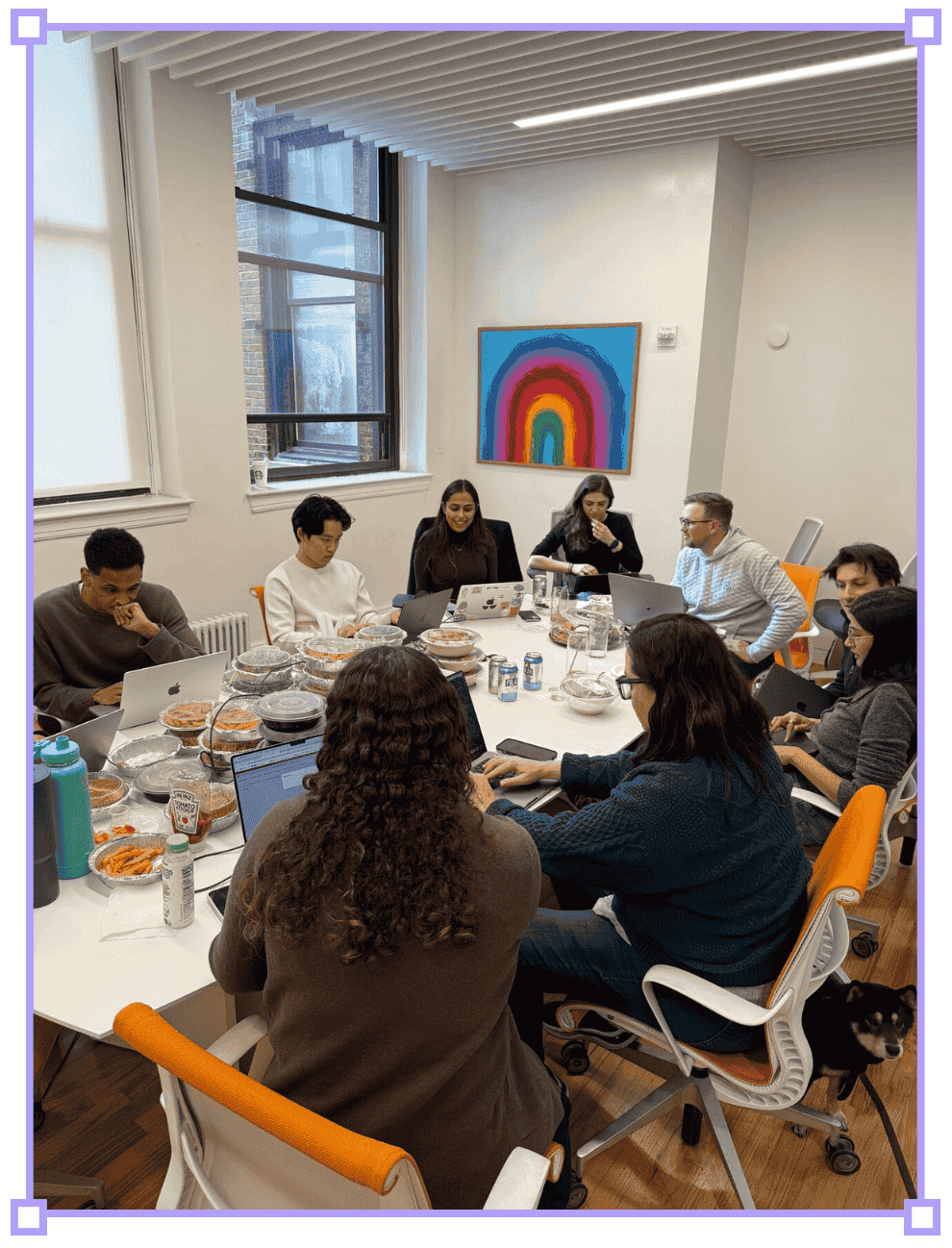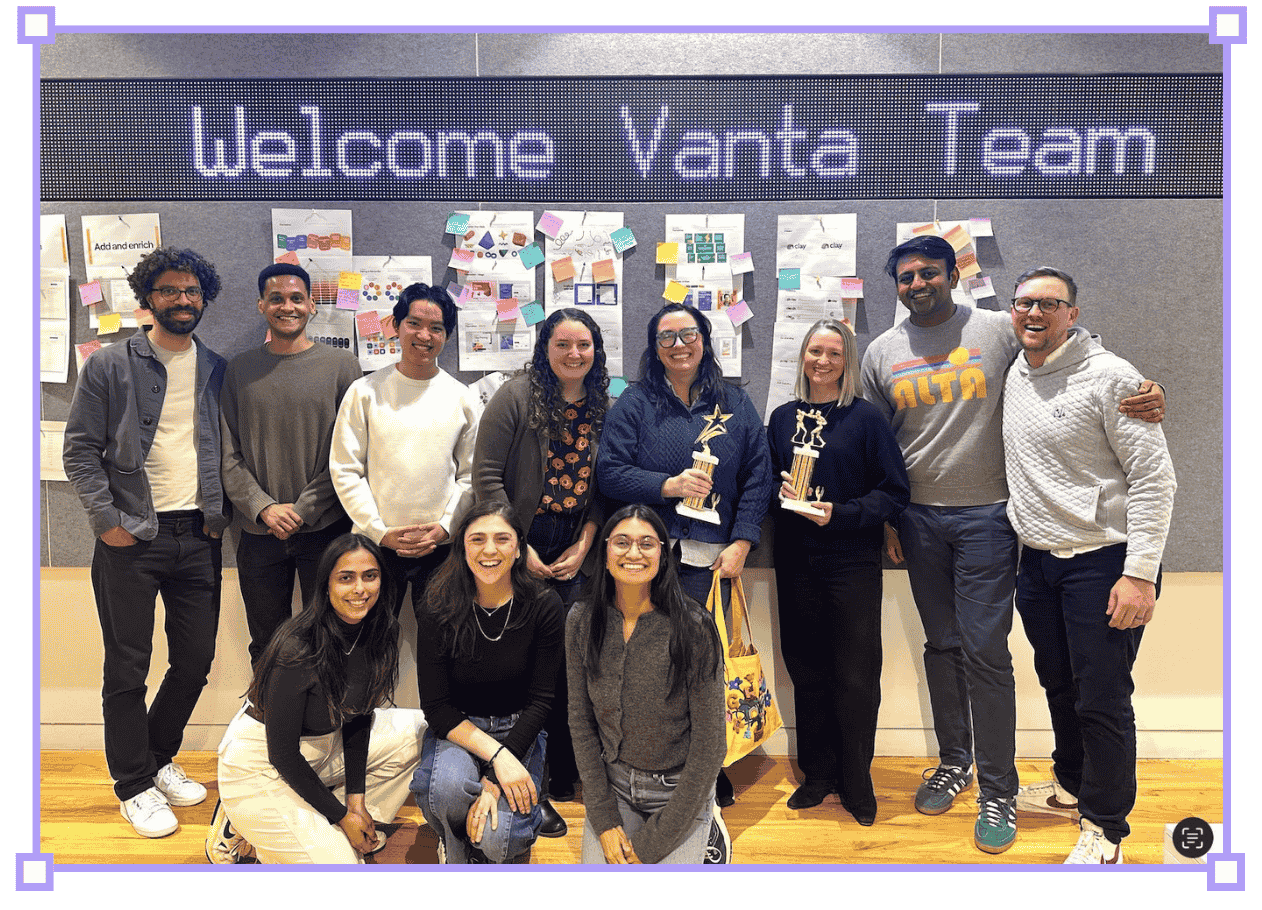- Strategy Breakdowns
- Posts
- 🎯 Clay’s hackathon playbook
🎯 Clay’s hackathon playbook
30 hackathons per quarter = 5x expansions + viral content
Read time: 4 minutes 39 seconds

A few months ago I was doom-scrolling LinkedIn (no judgement pls) when a video stopped me mid-scroll.
A serendipitous text message between tech execs.
A peek behind the curtain at how top companies are using AI.
A room full of grown adults cheering at the automated workflows they’d just built.
→ It was Clay’s first viral customer hackathon.
Fast-forward a few days and I saw another viral Clay video. And another one.
I knew I had to reach out to the team to find out more about the strategy. Turns out there’s a lot more to it than meets the eye.
They let me partner up with Head of Customer Experience Jess Bergson to unpack why they’re doubling down on in-person hackathons, and share the exact operational playbook that’s powering their latest growth channel.
Enjoy.
— Tom
P.S. Clay recently launched The GTM Engineer - a newsletter focussed on one of the most fascinating intersections in tech: where revenue meets AI + automation.
We're at this inflection point where GTM is becoming an engineering discipline rather than just "sales and marketing," and Clay is one of the few companies actually pioneering and sharing the working playbooks.
Worth a read!



Chess Move
The what: A TLDR explanation of the strategy
Most SaaS companies treat customer success as an afterthought.
The typical playbook = focus all your energy on marketing and product.
Marketing: Generating attention + leads + signups.
Product: Either (a) fixing bugs, or (b) building features that will generate more attention + leads + signups.
The problem is, we make big promises to the customer about the transformation our product offers.
Then in order to extract that value, it’s often a more challenging and custom road than the customer expected.
You optimise your in-product onboarding to accelerate time-to-value, but the reality is the world’s most powerful products have non-linear journeys.
Customers have vastly different needs, and will use the same product to build vastly different solutions.
Some businesses cobble together a customer success function that looks like: send some best practice documentation + schedule a few onboarding calls + throw in a quarterly business review if you're feeling fancy…
but that doesn’t cut it for the top end of town.
Clay (a suite of “GTM engineering” tools) took a different approach entirely, recognising that investing in customer success actually drives marketing and product outcomes.
When Vanta's CRO texted Clay’s co-founder Varun about wanting to save their sales reps 10 hrs/wk each through AI, Clay invited them to spend a full day in the New York office with one goal: walk out at 5PM with 3 fully-built, deployed AI workflows that transform how Vanta's GTM team operates.
Clay's marketing team captured the behind-the-scenes footage, posted it to LinkedIn, and accidentally discovered the company’s next overpowered growth lever:
The video went viral and Clay was hit with a surge of inbound hackathon interest from other customers and prospects, sparking them to spin up a full-blown strategy around delivering hackathons at scale.
Today, Clay runs 20-30 customer hackathons per quarter (and growing!)

💡 | Strategy Playbook: Transform customer success from service delivery into collaborative value creation. |


Breakdown
The how: The strategic playbook boiled down to 3x key takeaways
1. Target the "scratching the surface" moment
Clay learned that their biggest retention risk (and growth opportunity) wasn't customers who struggled to get started - it was customers who got some value but plateaued.
The one thing that all of our customers are telling us no matter what type of customer they are is “We still feel like we are always just barely scratching the surface."
First-day onboarding is a solved problem. Most customers get themselves set up autonomously, and happily build their first few workflows by leveraging on-demand resources + education.
 Youtube - Tutorials, feature drops, and interviews from Clay’s in-house content team.  Claybooks - Resources and templates to build powerful workflows in Clay. |  Clay’s Community - Announcements, support, intros, requests, and feedback from the ecosystem of Clay users and partners.  Clay University - The productised learning pathway for folks who are serious about mastering Clay. |
But as they build, they discover the power the platform offers beyond their early workflows, and inevitably start to think bigger about the GTM transformation it could enable.
Clay found the ‘sweet spot’ for hackathons was customers 3-6 months into their journey → they’ve built foundational workflows that add value, but haven't yet created the trajectory-altering "sexy" automations that get showcased at company all-hands meetings.
Here’s the exact playbook they run for this target segment:
→ Pre-hackathon reconnaissance: In the lead-up to the big day, customers brainstorm their "wildest dreams" - the workflows they've always wanted to build but never had time to focus on.
→ Early alignment: To kick-off, Clay spends 45 minutes understanding, validating, and visualising these ‘dream automations’, including defining end-of-day success criteria, and assigning Clay reps to customer breakout groups.
→ Customer-led building: Customer teams take ownership of their workflows, decide on design, and actively build their solutions. Clay employees are there to unblock, teach, and suggest - not drive.
→ Deployment deadline: Every workflow is live and running by 5PM. Not demos, not prototypes - real solutions solving real problems. Teams present their creations, and Clay captures the whole thing on camera.
Customers who felt like they were using <25% of Clay's capabilities walk away with tangible wins, bigger ambitions, and more confidence to keep unlocking the full potential of the platform.
2. Create viral content through authentic customer stories
Instead of scripted testimonials, Clay gets to capture genuine customer delight when teams successfully deploy workflows they've dreamed about for months.
Videos (not text) of the actual moments (not months after) creates natural viral content opportunities:
→ In-flow: The first test run that works as planned. The success notification in Slack. The stakeholder research brief landing in your inbox. Real smiles from real wins.

→ Show and tell: Each hackathon ends with teams sharing their creations with the group. Customers can’t help but become proud presenters of their own success stories.

→ Trophy ceremony: Clay gives custom awards to each participating team member, creating memorable moments that customers share organically.

→ Raw journeys: By capturing the initial goal-setting through to the live presentations, Clay gets to document authentic end-to-end customer transformations.

These moments become Clay's most powerful marketing assets - customer stories that prospects actually believe because they're undeniably real.
It’s no small feat to (a) generate transformational wins, and (b) capture the exact moments they happen, and Clay has built an engine to drive them both - on repeat.
The strategy scales through systems:
Clay uses Clay itself to capture inbound demand, score and prioritise accounts, and optimise hackathon processes.
Clay runs 6 hackathons across 3 days when they travel to cities like San Francisco, then hosts dinners where all participants share their builds with prospects and other customers.
Clay tracks business impact on expansions and renewals, enabling ROI-positive reinvestment to keep growing the program.
The other day a customer increased their spend by 5x after their hackathon. We view customer success as getting our customers to a point where they want to scream from the rooftops about the value that they're seeing. It’s the best marketing you can dream of!
3. Product discovery flywheel
The hardest (and most important) part of building software is building things that customers actually want.
Companies end up playing ‘the guessing game’: engineers build what they think customers want, then product marketing figures out how to sell it.
Clay uses their hackathons as an R&D lab - placing engineers directly in the customer loop to discover real problems.
In the lead-up to a recent hackathon, the customer wanted to use Clay’s AI research agent, but needed it to reference their extensive product documentation.
A Clay engineer took the customer’s hackathon prep notes, spent the week building PDF context upload functionality, then attended the hackathon to learn from the customer using what they had built in real-time.
The fixed date of an upcoming hackathon creates a short feedback loop: the engineer builds the new feature, then gets to observe it in the hands of real customers less than 7 days later.
At scale, this process creates a flywheel:
→ Hackathons build Clay's feature set: Each event teaches Clay new customer use cases and drives validated feature development.
→ Enhanced capabilities drive bigger customer wins: Better features and refined processes lead to more impressive hackathon outcomes and stronger case studies.
→ Bigger wins create more compelling viral stories: More dramatic transformations generate more shares and more attention.
→ Viral stories generate qualified inbound demand: Other companies see authentic peer success and request their own hackathons - pre-sold on the value.
→ More demand drives more product discovery: New attendees bring new problems and new create validated roadmap ideas for Clay.
A self-correcting discovery algorithm that drives product-market-fit.


What did you think of today's edition? |
Thanks to the generous folks at Clay HQ for letting us unpack their entire playbook.
Check out The GTM Engineer for more frontier sales and marketing automation ideas!


Whenever you're ready, there are 3 ways we can help you:
Our flagship course on how to use free internet data to make better strategic decisions. Contains 5 years of strategy expertise, proven methods, and actionable tactics to accelerate your career with modern-day strategy skills.
We have a growing audience of 80,000+ strategists from top companies like Google, Meta, Atlassian, Stripe, and Netflix. Apply to feature your business in front of Strategy Breakdowns readers.
One of the most common questions we get asked is: “What tools do you use to run Strategy Breakdowns?” So, we’ve open-sourced our tech stack to give you an inside-look at exactly what tools we’re using to power each corner of this operation.




Reply